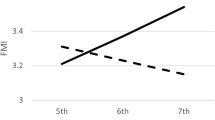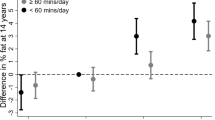Abstract
Objective: To identify whether measures of energy intake and expenditure predict excessive weight gain over time in children and to describe how these measures relate to similar measures in parents.
Design: Prospective, descriptive study over 12 months with no intervention.
Setting: University teaching hospital.
Subjects: Children aged between 6.0 and 9.0 y. Recruitment was through advertisement. A total of 59 children (30 F), 41 mothers and 29 fathers. In all, 41 (69%) of the children were reviewed at 12 months (20 F).
Results: No significant correlations were identified between body mass index (BMI) z-score change in children over 12 months for any dietary variable or for any measures of energy expenditure, including hours of television viewing or percent time spent in low-, moderate- or high-intensity activity. The BMI z-score change over 12 months was significantly correlated with LDL cholesterol and Apo B/ApoA-1 ratio, independent of percent body fat (r=0.45, P=0.01; r=0.37, P=0.03). A significant positive correlation was found for mothers and girls for percent time in moderate to high activity (r=0.44, P=0.03) and between fathers and children for percent time spent in low activity (r=0.43, P=0.005).
Conclusions: The study has been unable to identify environmental predictors that indicate propensity to faster weight gain over time in this cohort of children, but has extended the evidence on lifestyle-influenced biochemical predictors that do. An overall lack of vigorous activity in this age group, and correlations between parental and child activity and inactivity have been identified.
Sponsorship: The Australian Rotary Health Foundation, The Financial Markets Foundation for Children, The National Health and Medical Research Council.
This is a preview of subscription content, access via your institution
Access options
Subscribe to this journal
Receive 12 print issues and online access
$259.00 per year
only $21.58 per issue
Buy this article
- Purchase on Springer Link
- Instant access to full article PDF
Prices may be subject to local taxes which are calculated during checkout

Similar content being viewed by others
References
Arciero PJ, Goran Ml & Poehlman ET (1993): Resting metabolic rate is lower in women than in men. J. Appl. Physiol. 75, 2514–2520.
Australian Bureau of Statistics (1998): National Nutrition Survey 1995: User's Guide. Canberra:AGPS; 1998. ABS Cat No: 4801.0.
Ball EJ, O'Connor J, Abbott R, Steinbeck KS, Davies PSW, Wishart C, Gaskin KJ & Baur LA (2001): Total energy expenditure, body fatness and physical activity in children aged 6.1–9.6 years. Am. J. Clin. Nutr. 74, 524–528.
Baur LA, Ball EJ, O'Connor J, Steinbeck KS, Gaskin KJ, Wishart C & Davies PSW (2000): Physical activity, energy expenditure & body fatness in 6–8 year old children. Int. J. Obesity 24(Suppl 1), S30.
Berkey CS, Rockett HRH, Field AE, Gillman MW, Frazier AL, Camargo CA & Colditz GA (2000): Activity, dietary intake and weight changes in a one year longitudinal study of preadolescent and adolescent boys and girls. Pediatrics 104, e56.
Birch LL & Fisher JO (2000): Mothers' child feeding practices influence daughter' eating and weight. Am. J. Clin. Nutr. 71, 1054–1061.
Bouchard C, Tremblay A, Leblanc C, Lortie G, Savard R & Theriault G (1983): A method to assess energy expenditure in children and adults. Am. J. Clin. Nutr. 37, 461–467.
Byrnes S, Steinbeck K, Baur L, Bermingham M & Brock K (1999): Leptin and total cholesterol are predictors of weight gain in pre-pubertal children. Int. J. Obesity 23, 146–150.
Champagne CM, Baker NB, Delany JP, Harsha DW & Bray GA (1998): Assessment of energy underreporting by doubly labelled water and observations on reported nutrient intakes in children. J. Am. Diet. Assoc. 98, 426–433.
Dennison B, Straus J, Mellits E & Charney E (1988): Childhood physical fitness tests: predictor of adult physical activity levels?. Pediatrics 82, 324–330.
Duke PM, Litt IF & Gross RT (1980): Adolescent's self-assessment of sexual maturation. Paediatrics 66, 918–920.
DuRant R, Baranowski T, Johnson M & Thompson W (1994): The relationship among television watching, physical activity, and body composition of young children. Pediatrics 94, 449–455.
Dwyer J, Stone E, Yang M, Feldman H, Webber L, Must A, Perry C, Nader P & Parcel G (1998): Predictors of overweight and overfatness in a multiethnic pediatric population. Am. J. Clin. Nutr. 67, 602–610.
Fisher JO & Birch LL (2000): Parents' restrictive feeding practices are associated with young girls' negative self evaluation of eating. J. Am. Diet. Assoc. 100, 1341–1346.
Fogelholm M, Nuutinen O, Pasanen M, Myohanen E & Saatela T (1999): Parent–child relationship of physical activity patterns and obesity. Int. J. Obesity 23, 1262–1268.
Fontvieille A, Harper I, Ferraro R, Spraul M & Ravussin E (1993): Daily energy expenditure by five-year-old children, measured by doubly labelled water. J. Pediatr. 123, 200–207.
Friedewald WT, Levy Rl & Fredrickson DS (1972): Estimation of the concentration of low-density lipoprotein cholesterol in plasma, without use of the preparative ultracentrifuge. Clin. Chem. 18, 499–502.
Gazzaniga JM & Burns TL (1993): Relationship between diet composition and body fatness, with adjustment for resting energy expenditure and physical activity in preadolescent children. Am. J. Clin. Nutr. 58, 21–28.
Goldberg GR, Black AE, Jebb SA, Cole TJ, Murgatroyd PR, Coward WA & Prentice AM (1991): Critical evaluation of energy intake data using fundamental principles of energy physiology: 1. Derivation of cut-off limits to identify under-recording. Eur. J. Clin. Nutr. 45, 569–581.
Goran M, Shewchuk R, Gower B, Nagy T, Carpenter W & Johnson R (1998): Longitudinal changes in fatness in white children: no effect of childhood energy expenditure. Am. J. Clin. Nutr. 67, 309–316.
Gortmarker S, Must A, Sobol A, Peterson K, Colditz G & Dietz W (1996): Television viewing as a cause of increasing obesity among children in the United States, 1986–1990. Arch. Pediatr. Med. 150, 356–362.
Hammer LD, Kraemer HC, Wilson DM, Ritter PL & Dornbusch SM (1991): Standardized percentile curves of body-mass index for children and adolescents. Am. J. Dis. Child 145, 259–263.
Huttunen N, Knip M & Paavilainen T (1986): Physical activity and fitness in obese children. Int. J. Obesity 10, 519–525.
Klesges RC, Klesges LM, Eck LH & Shelton ML (1995): A longitudinal analysis of accelerated weight gain in preschool children. Pediatrics 95, 126–130.
Koivisto Hursti UK (1999): Factors influencing children's food. Ann. Med. 31(Suppl 1), 26–32.
Malina R, Beunen G, Claessens A, Lefevre J, Eynde B, Vanreusel B & Simons J (1995): Fatness and physical fitness of girls 7 to 17 years. Obesity Res. 3, 221–231.
Mamalakis G, Kafatos A, Manios Y, Anagnostopoulou T & Apostolaki I (2000): Obesity indices in a cohort of primary school children in Crete: a six year prospective study. Int. J. Obesity 24, 765–771.
Molnar D & Schutz Y (1997): The effect of obesity, age, puberty and gender on resting metabolic rate in children and adolescents. Eur. J. Paed. 156, 376–381.
Montoye HJ (1975): Physical Health and Activity; an Epidemiological Study of an Entire Community. Englewood Cliffs, NJ: Prentice-Hall.
Moore L, Lombards D, White M, Campbell J, Oliveria S & Ellison R (1991): Influence of parents' physical activity levels on activity levels of young children. J. Pediatr. 118, 215–219.
Moore LL, Nguyen U-S DT, Rothman KJ, Cupples LA & Ellison RC (1995): Preschool physical activity and changes in body fatness in young children. Am. J. Epidemiol. 142, 982–988.
Moussa M, Skaik M, Selwanes S, Yaghy O & Bin-Othmann S (1994): Factors associated with obesity in school children. Int. J. Obesity 18, 513–515.
New South Wales Schools Fitness and Physical Activity Survey (1997): ISBN 1 86451 325 X; Publication of the NSW Department of Education and Training.
Pereira MA, Fitzgerald SF, Joswiak MP, Ryan WJ, Suminiski RR, Utter AC & Zmuda JM (1997): A collection of physical activity questionnaires for health-related research. Med. Sci. Sports Exer. 29(Suppl), S9–S24.
Sallis J McKenzie T & Nader P (1988): Family variables and physical activity in preschool children. J. Dev. Behav. Pediatr. 9, 57–61.
Sichert-Hellert W, Kersting M & Schoch G (1998): Underreporting of energy intake in 1–18 year old German children and adolescents. Z. Ernahrungswissenschaft 37, 242–251.
Ward D, Trost S, Felton G, Saunders R, Parsons M, Dowda M & Pate R (1997): Physical activity and physical fitness in African–American girls with and without obesity. Obesity Res. 5, 572–577.
Westrate JA & Deurenberg P (1991): Body composition in children: proposal for a method for calculating body fat percentage from total body density or skin-fold thickness measurements. Am. J. Clin. Nutr. 50, 1104–1115.
World Health Organisation (1998): Obesity, preventing and managing the global epidemic. Report of a WHO Consultation on Obesity, Geneva, 3–5 June 1997.
Author information
Authors and Affiliations
Contributions
Guarantors: K Steinbeck, L Baur, and M Bermingham.
Contributors: NB was the research assistant for the project. She finalised the study, performed the statistical analysis and wrote the paper to final draft stage. KS and LB are both physicians and applied for the grant which allowed this study to be undertaken. They were cosupervisors of the study and produced the final version of the paper. KB is an epidemiologist and dietitian who was part of the original grant application and who helped NB with all the statistical analysis. MB is a lipid biochemist whose laboratory performed the lipid analyses, who was involved in advice on the grant application and who made a significant contribution to the writing of the paper.
Corresponding author
Rights and permissions
About this article
Cite this article
Bogaert, N., Steinbeck, K., Baur, L. et al. Food, activity and family—environmental vs biochemical predictors of weight gain in children. Eur J Clin Nutr 57, 1242–1249 (2003). https://doi.org/10.1038/sj.ejcn.1601677
Published:
Issue Date:
DOI: https://doi.org/10.1038/sj.ejcn.1601677
Keywords
This article is cited by
-
Unhealthy weight among children in Spain and the role of the home environment
BMC Research Notes (2018)
-
Parental correlates in child and adolescent physical activity: a meta-analysis
International Journal of Behavioral Nutrition and Physical Activity (2015)
-
Prevalence of overweight, obesity, and associated risk factors among school children and adolescents in Tianjin, China
European Journal of Pediatrics (2012)
-
Watching television is associated with childhood obesity: but is it clinically important?
International Journal of Obesity (2006)
-
Physical activity and sedentary behavior: a review of longitudinal studies of weight and adiposity in youth
International Journal of Obesity (2005)



